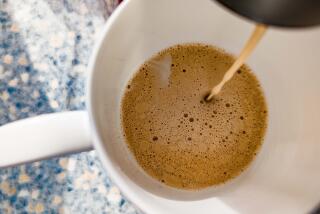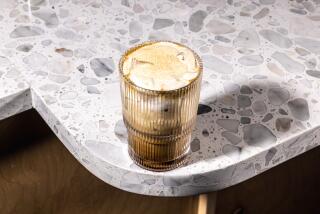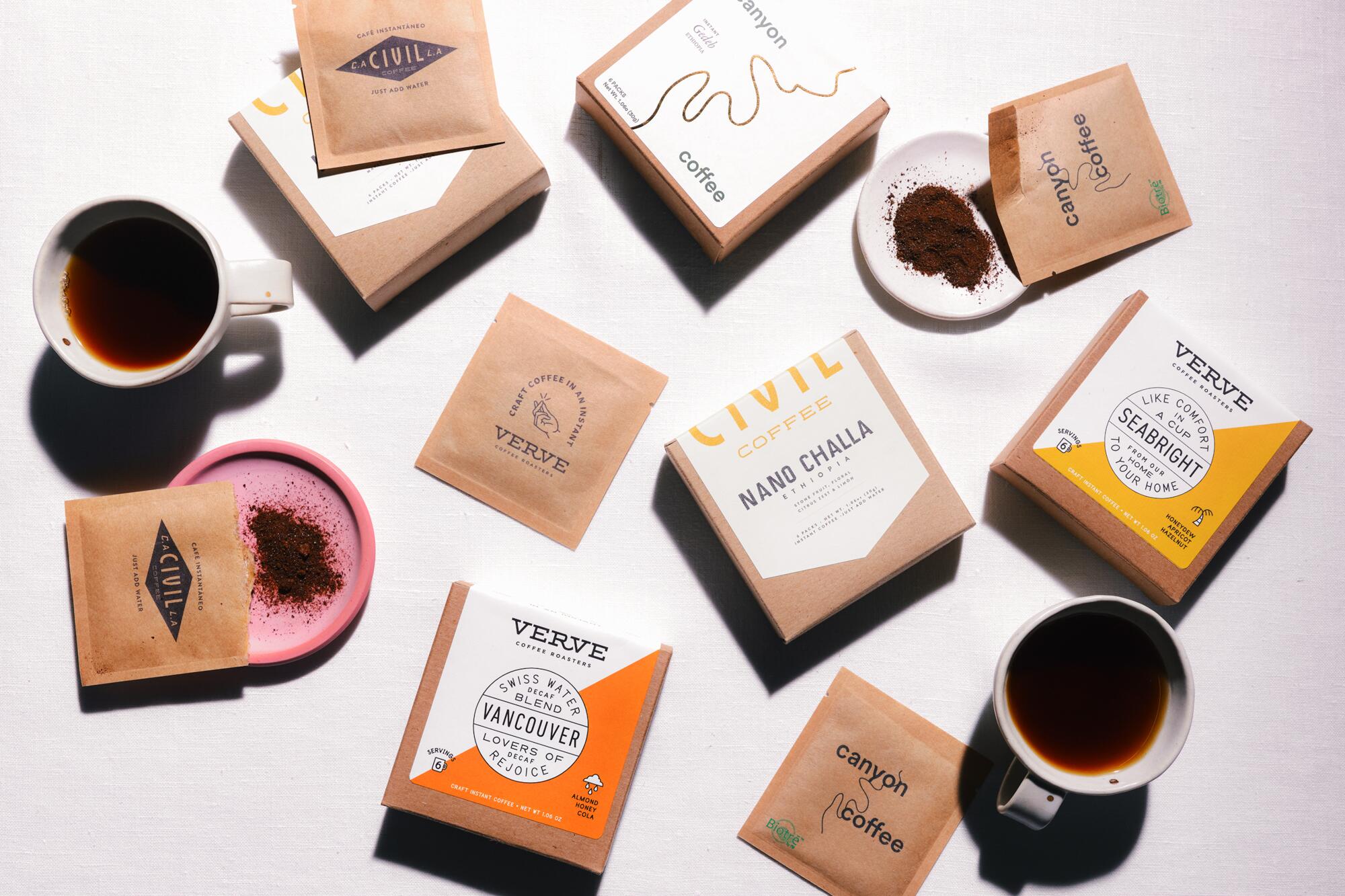
The specialty instant-coffee revolution has reached your local roaster. We taste several West Coast instant coffees in search of the best. Which ones are good? Are they worth the money?
Instant coffee. Lately, everybody loves it. And not just your Folgers-drinking grandparents but venture capitalists, third-wave coffee roasters and aficionados who formerly might have disdained it. That’s largely because instant coffee has been overhauled in the last five years. Sold in ever-new forms and packaging, it no longer tastes unilaterally bad — and it isn’t cheap.
But can new-wave instant coffee come closer to replacing your freshly brewed cup? Does its aroma match those of just-crushed roasted beans? Can it transport you from groggy and downtrodden to bright-eyed and uplifted on a magic carpet ride of flavor and caffeine? And as expensive as it can be, is it a good value? It’s a lot to ask.
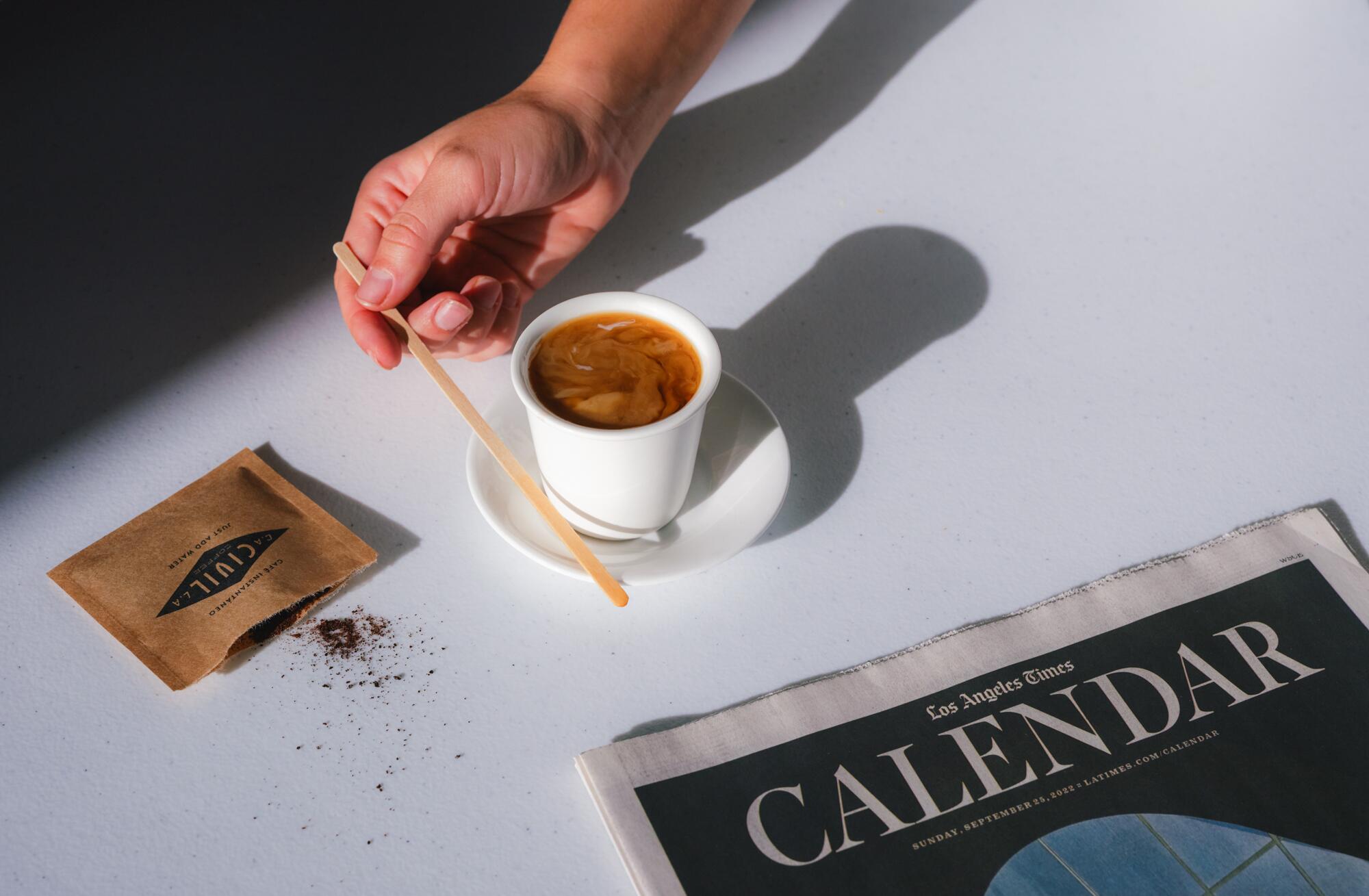
Generations drank — and still drink — instant coffee as freeze-dried crystals from canisters of Nescafé, an American staple ever since a prototype was introduced during World War II. Demand for instant coffee already had been established in the first World War, when soldiers drank a predecessor called G. Washington’s Coffee (or “a cup of George” rather than Joe), named not for the father of our country but for George Constant Louis Washington, who is credited as the first mass producer of instant coffee with his Red E Coffee (as in “ready”).
Attempts at making instant coffee go back at least to 1771, when John Dring patented his “coffee compound” process in Britain. But this and other methods, including cakes of ground coffee used during the Civil War, were said to go rancid quickly. In 1901, Chicago-based Japanese chemist Satori Kato introduced a shelf-stable instant coffee at the Pan-American Exposition in Buffalo, N.Y. In the 1950s, advances in freeze-drying technology helped produce instant coffee as we know it (without stabilizers, just coffee in the jar) — or had known it until now.
How is instant coffee made?
Most instant coffees are still made the same way. Green coffee beans (historically not of good quality) are roasted and finely ground, then brewed with extremely hot, pressurized water. An evaporation process concentrates the liquid brew, which is frozen at minus 40 degrees and vacuum-dried. What results is a powdered instant coffee that can be dissolved with just boiling water.
Enter “craft” instant coffee, or “specialty” instant coffee. Made with the highest-grade beans, craft instant coffee is pricy compared to grinding and brewing coffee from whole beans or even compared to single-serving pods of ground coffee. Most of the instant coffees we tried were $12 to $20 for a box of five or six single-serving packets. In comparison: A 12-ounce bag of beans from Verve costs $18.75 and yields more than 20 cups. And we found Keurig K-Cup pods of Starbuck’s Pike Place Roast ground coffee priced at $19.99 for a box of 22 single-serving pods. Folgers? An 8-ounce jar of Folgers Classic Roast Instant Coffee Crystals ($6.48 at Sam’s Club) makes up to 120 cups.
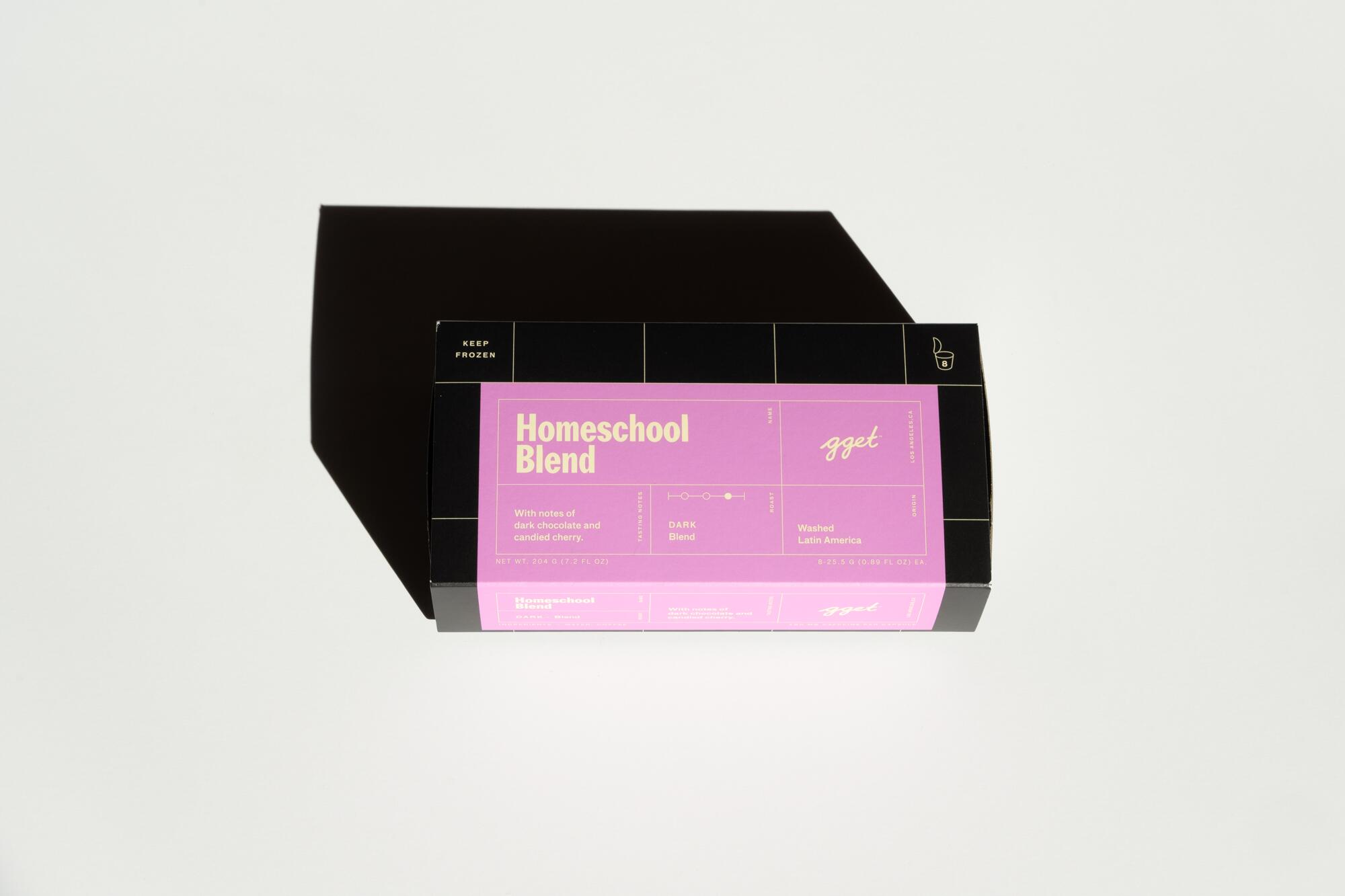
Upstart co-manufacturers such as Swift Coffee in Pennsylvania, San Francisco-based Sudden Coffee and Voilà out of Oregon all started processing instant coffee for a clientele of specialty roasters in 2015 and 2016. Sudden was one of the first food companies to be accepted by business accelerator Y Combinator. You could buy acrylic neon flip-top cases for your sachets of instant coffee from Voilà. They collaborated with roasters such as Coava, Ritual, Equator and Joe.
Was so much instant coffee too much of a good thing? Sudden was suddenly gone, closed during the pandemic. Voilà disappeared, closing in 2021. But Swift now co-manufactures instant coffee for 150 roasters in the U.S. and Canada, says founder Nate Kaiser, and produces 4 million to 5 million servings annually. He started the company in his basement with secondhand lab equipment with the goal of making quality coffee more accessible.
“Specialty coffee is widely available, but I live in a rural part of Pennsylvania where that’s not the case,” Kaiser says. “I wanted to know, is it even possible to make a better version of instant coffee?”
Massachusetts-based Cometeer, whose prominent fans include chef David Chang, upended the coffee-that-dissolves-in-water category with its frozen capsules. The company also starts with beans from specialty roasters, ground for optimal particle size. The coffee is brewed at 10 times the strength of a regular cup and flash-frozen with liquid nitrogen — colder than 300 degrees below zero.
“We optimize for all the variables that are so difficult to optimize at home or in a cafe setting,” founder Matt Roberts says via email, “including water chemistry, grind size uniformity, pressure, flow rate and more. We actually measure exactly what we pull out of the bean with each brew.”
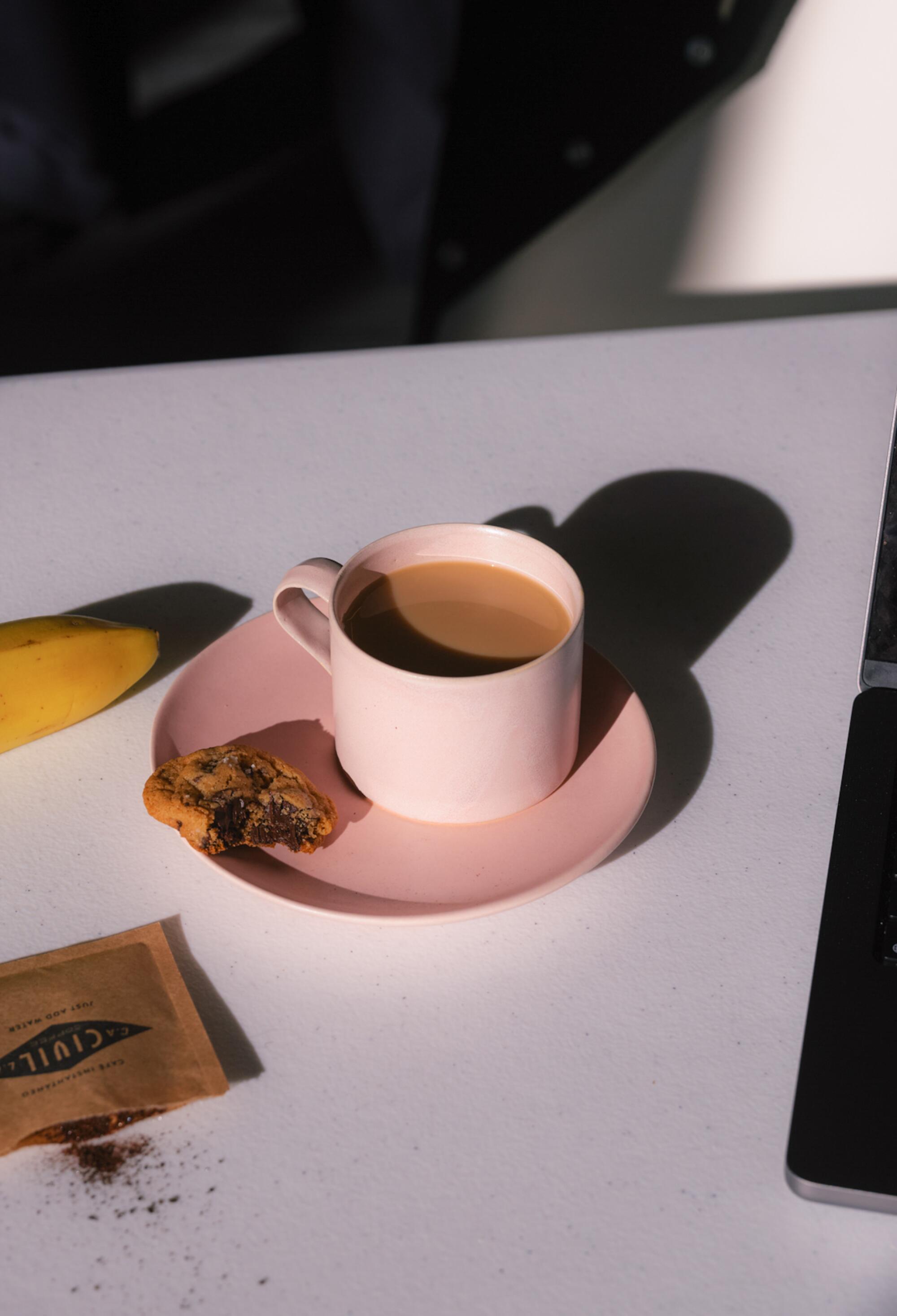
The company, which had raised $100 million by late 2021 (the most-funded coffee startup ever), recently conducted layoffs, but Roberts says Cometeer “is seeing strong month-over-month [sales] growth via new retail and food service channels.” The capsules are available online, packaged with dry ice and shipped to customers. Since last summer, they also are sold at Erewhon stores in Los Angeles.
As the market expands, locally roasted craft instant coffee has become more of a factor and increasingly available. Your favorite L.A. shop may offer its own instant roast, though it’s likely processed across the country.
Intelligentsia embraced instant coffee so much that in March of last year it transformed its Pasadena location — serving only instant espresso for all its drinks. Walk into the Colorado Boulevard shop, and you won’t find baristas pulling shots from any espresso machines; instead, there are hot water stations and milk-frothing minirobots.
Which instant coffee tastes best?
So while the pursuit of better instant coffee continues, it’s time to sip. An L.A. Times Food tasting panel tried nine instant coffees, most from Los Angeles or California. Verve is based in Santa Cruz but has multiple locations in L.A. Blue Bottle was purchased by Nestlé, and Intelligentsia is now owned by Peet’s, but they are included for comparison. (And Intelligentsia’s instant-espresso Illumination Bar in Pasadena is the first of its kind.) The tasters were deputy Food editor Betty Hallock; Times columnists Lucas Kwan Peterson and Jenn Harris; a professional nose, perfumer Ashley Kessler; and coffee shop owner Jack Benchakul of Endorffeine (which does not sell instant coffee). Here’s what we liked, or didn’t.
All of the following coffees were prepared according to directions with 8 to 10 ounces of water, heated to between 195 and 200 degrees.
If you drink black coffee ...
These are light to medium roasts, in the L.A. “style,” with bright or sometimes amplified acidity. With very light body, these single-original coffees were best without milk.
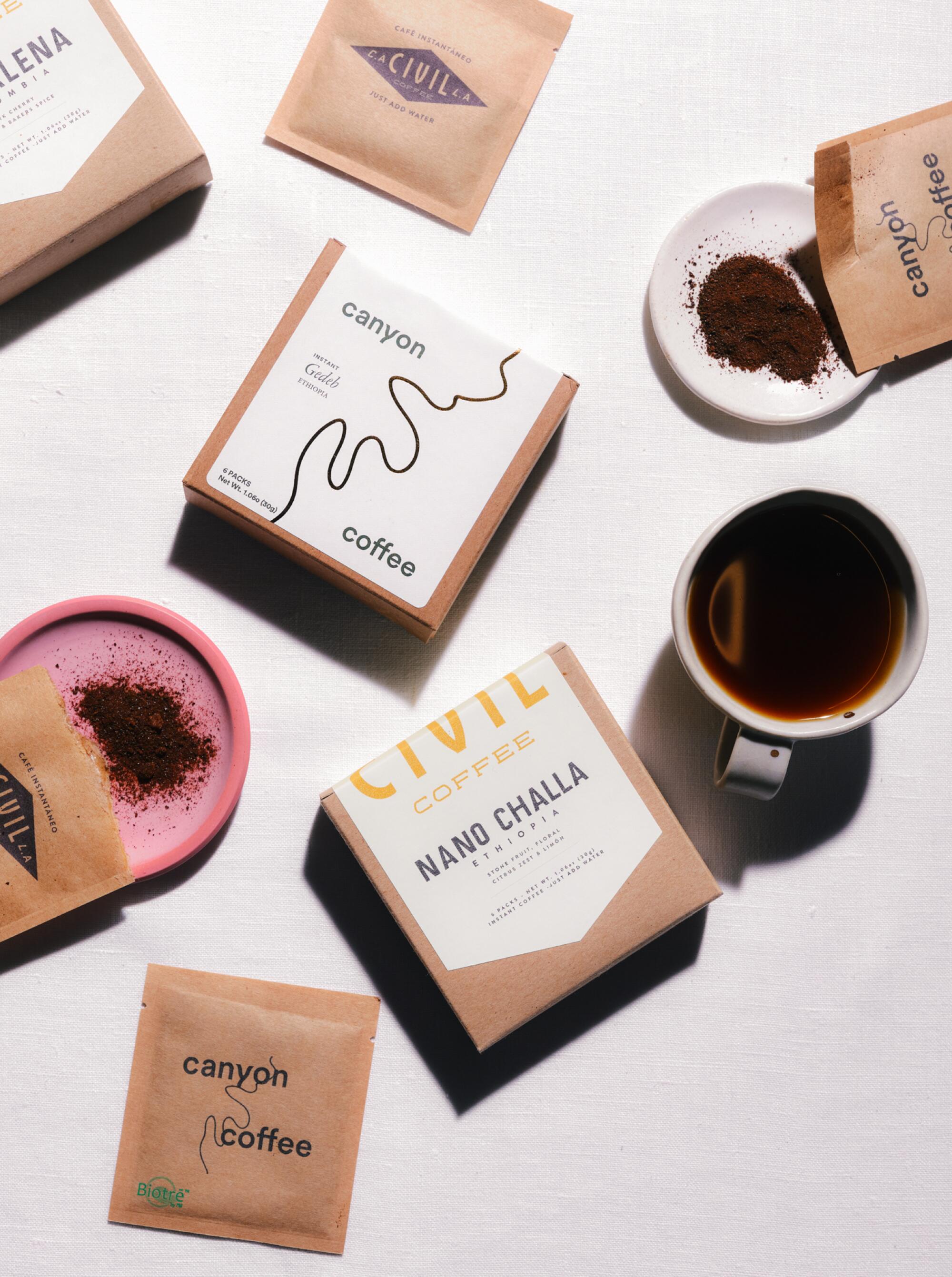
Civil Coffee — Nano Challa, Ethiopia
The small-lot coffee from the Nano Challa cooperative in Oromia had the most robust aroma straight out of the packet: chocolate, dried apricot, cool spices. But across this category the light to medium roasts lacked the body that can help carry flavor. “It’s like music in the next room, but you can’t quite make it out,” Peterson said. The poles of good coffee — acidity and sweetness — are transmuted, but both are still enjoyable in this cup, even if the flavor can dissipate quickly. “In a pinch, on its own,” said Benchakul, “it’s pretty good.”
Cost: $16 for six servings ($2.67 per cup)
Canyon Coffee — Gedeb, Ethiopia
Another variety from Ethiopia, this one elicited the remark, “I’m surprised that instant coffee isn’t a huge disappointment.” Once hot water was added, it smelled of lemon, magnolia and tropical fruit; it tasted savory, almost fermented, with “a crystalline sugar note” and “a shade more body” than the Civil Ethiopian. The pronounced acidity was balanced more by bitterness than sweetness, and flavors seemed one-note and encapsulated, “as if someone was putting one drop on your tongue. Bop!” said Kessler. Even so, “This one was the most interesting, as in a curiosity.”
Cost: $20 for six servings ($3.33 per cup)
Civil — Magdalena, Colombia
“I like this one, it’s got something there,” said Peterson. “It’s got some balance.” Gently chocolatey, with juicy acidity that didn’t put tart on blast, it was the sweetest in this category, with a clean finish and very light body but all-around pleasant. “It’s a silhouette of a pour-over,” said Benchakul. “For an instant coffee, that’s impressive.”
Cost: $16 for six servings ($2.67 per cup) Best light to medium roast
If you drink coffee with milk ...
These coffees — strong and especially chocolatey — are medium to dark roasts, tasted with and without dairy, oat and nut milks (*tested only as hot coffee, not cold).
Verve Seabright House Blend
Verve Coffee Roasters offers several instant coffee blends. Seabright is a medium roast of beans from Guatemala and El Salvador. The directions say you can use “hot or cold* liquid (water, milk or milk alternative), stir and drink up.” For some reason, the coffee came out of the envelope in one or two clumps rather than a loose powder and didn’t dissolve easily. The aroma was earthy and slightly smoky, with surprisingly dense viscosity. “It’s actually not as bad as I thought it was going to be,” said Benchakul. “I’m shocked.” But there was no immediate pop or brightness. The closest thing to diner coffee.
Cost: $16 for six servings ($2.67 per cup) or $48 for 25 servings ($1.92 per cup)
Intelligentsia House Coffee
Straight out of the package, the aroma of this instant coffee is all chocolate. “If you told me this was hot cocoa, I’d believe you,” Harris said. In the cup, it’s an especially milk-chocolatey coffee with notes of citrus, and it holds up well when mixed with milk. This was our favorite with milk, but both the Intelligentsia and Verve darker roasts had a tannic, drying quality. Milk helped mitigate it.
Cost: $12 for five servings ($2.40 per cup) Best medium to dark roast
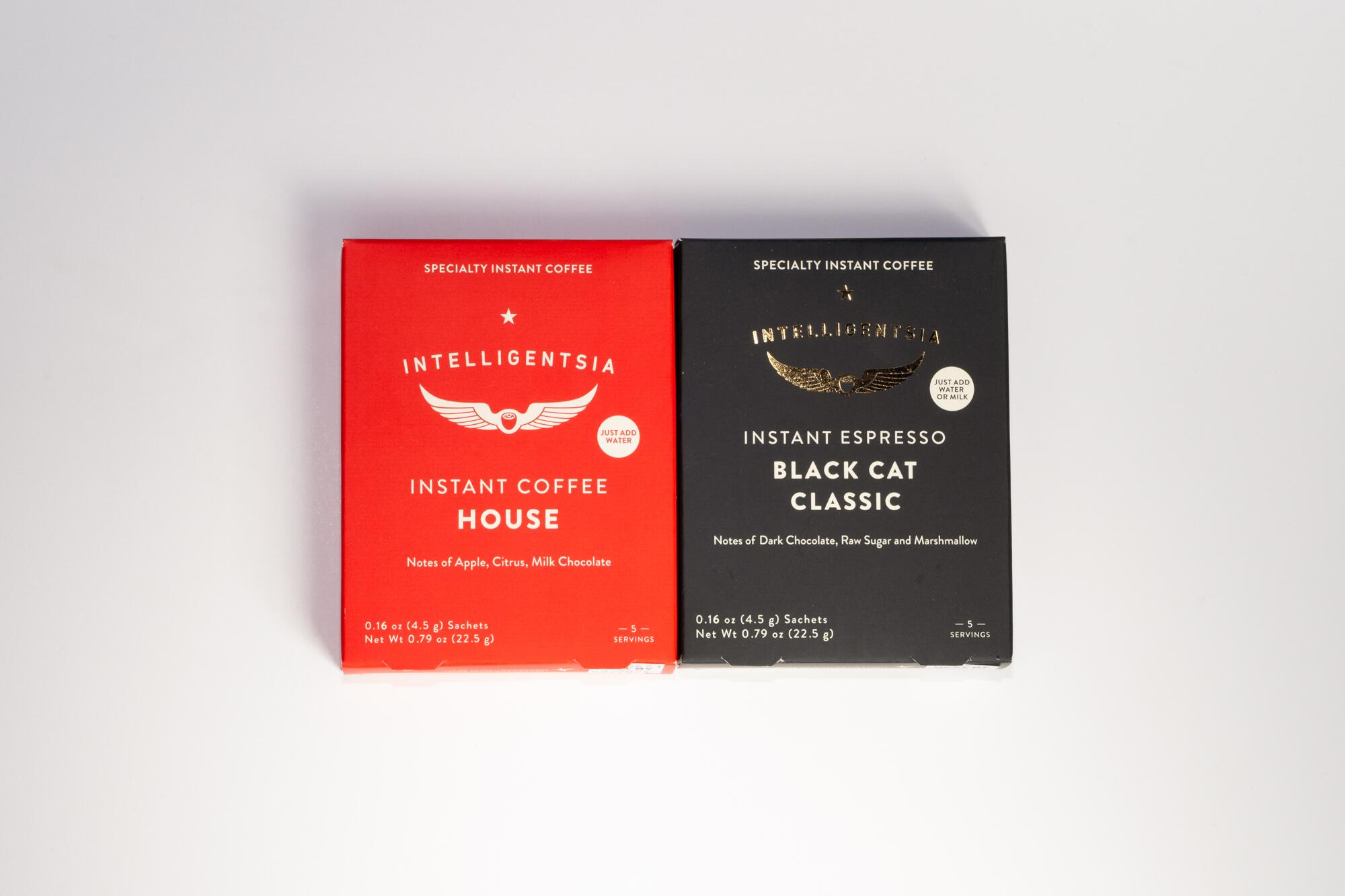
Notes on instant espresso
If you love a shot of espresso, we currently can’t recommend an instant version. These are the three we tried: Intelligentsia Black Cat Classic ($12 for five servings), Blue Bottle espresso ($25 for 12 servings) and Unincorporated Quiet Prophet espresso ($18 for six servings). Directions for all three varied widely (calling for anywhere between 1 and 8 ounces of liquid). The Blue Bottle espresso, according to its instructions, is meant solely for lattes. We tried it as straight espresso, but you absolutely should not. Of the three, the Intelligentsia Black Cat Classic made the best lattes but also wasn’t as enjoyable as an espresso.
Best overall instant coffee
There’s just no comparison, and in a way it isn’t fair to test the flavor of Cometeer against powdered instants — but we did because when it comes to add-water-and-stir coffee, it’s an option.
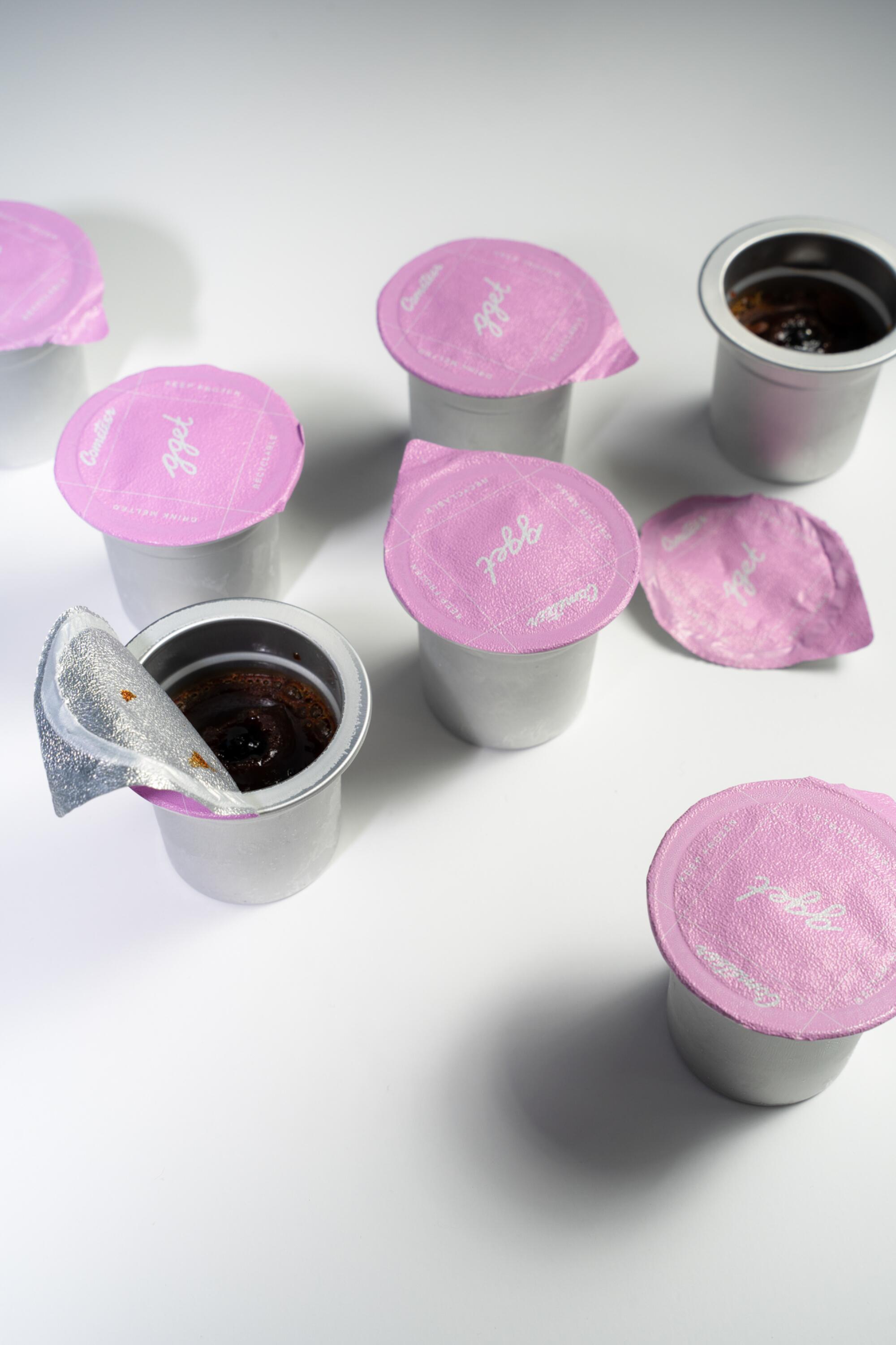
Cometeer / Go Get Em Tiger’s Peru Alpes Andinos
Cometeer’s Roberts says, “We don’t consider ourselves instant coffee, which is brewed and dehydrated ... and we are not a concentrate, either, which also involves the removal of water.” But if instant means “a very short span of time” and requires no brewing or special equipment, then we’ll consider it instant. Cometeer features coffees from several roasters, currently including Black & White, Counter Culture and L.A.-based Go Get Em Tiger. The GGET pack recently featured Peru Alpes Andinos. As a frozen puck of coffee, obviously it has no aroma. But once it melts, it smells richly of freshly brewed coffee. It’s the closest thing to the moment I open the canister of my hand-cranked Porlex Mini portable grinder (the only grinder I currently have) and the aroma of coffee feels as if it’s washing over me. Add water or milk, hot or cold, and it dissolves completely and creates a cloudless cup.
Reactions from the panel: “It’s like a pour-over. I quite like that.” “I enjoy this.” “The body is really interesting.” “This is amazing.”
$84 for 32 servings without subscription ($2.60 per cup); $64 for 32 servings with subscription ($2 per cup); at GGET locations, $24 for 8 servings ($3 per cup)
More to Read
Eat your way across L.A.
Get our weekly Tasting Notes newsletter for reviews, news and more.
You may occasionally receive promotional content from the Los Angeles Times.

